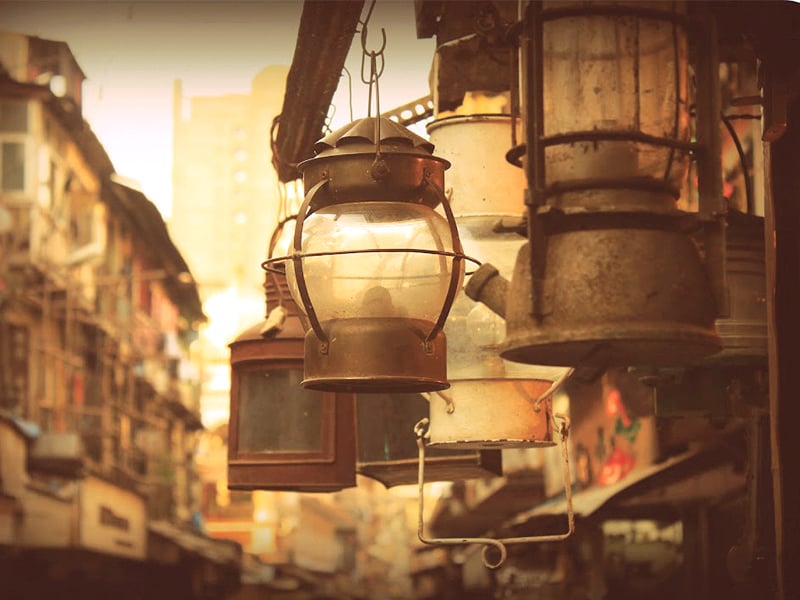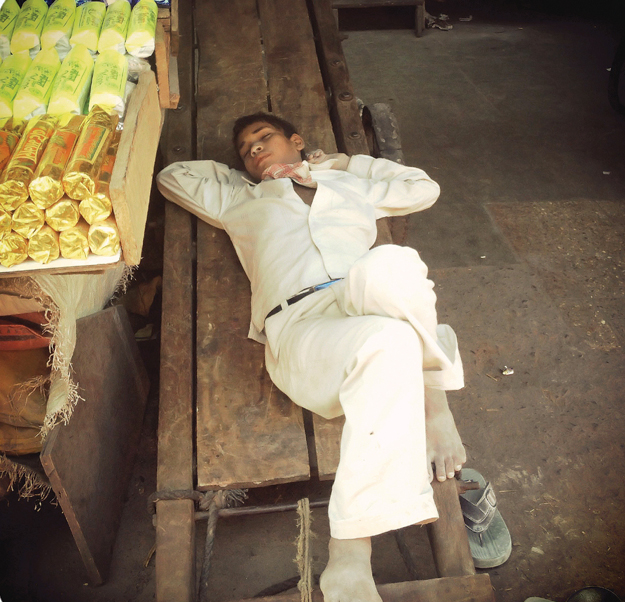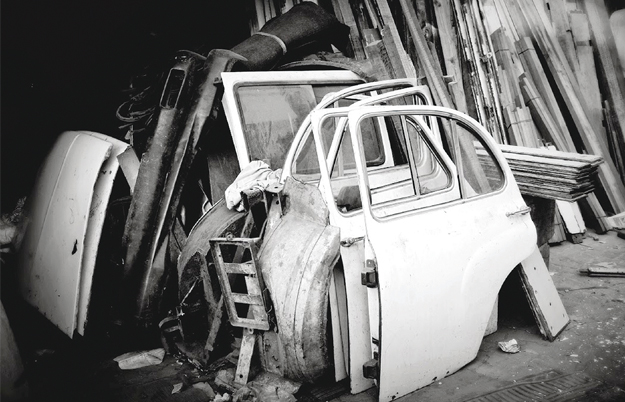
Housing the legendary “Chor Bazaar” or market of thieves, this quiet bylane is located amid the bedlam of south Mumbai. But getting to it is the real challenge. One has to circumvent bullock carts piled with melting blocks of ice carelessly covered in jute bags, navigate through bumper-to-bumper taxi traffic, dodge the brouhaha of street vendors and even trudge through cow dung and rotting fruit and vegetables swarming with flies from the neighbourhood fresh produce market.

A fairly common sight during an afternoon stroll in Chor Bazaar is a vendor on his siesta. PHOTO: PURVI THACKER
As the story goes, this flea market of sorts derived its name from the same adjacent mêlée, and was originally known as “Shor Bazaar” (market of noise). But over time, the British rendition reduced it to “Chor Bazaar”, which today seems more fitting, given that one can find smuggled and stolen goods among the glut of Rajput era antiques, vintage bric-a-brac and artifacts.

Everything from spare doors and car tires to logos and auto-parts can be replaced and purchased on the streets of Chor Bazaar. PHOTO: RACHANA MEHTA
Mutton Street is a nondescript dusty road that doesn’t have the chaos of local souks commonly reflected in the Bourne trilogy series or the stereotypical fanfare of a market seen in Bond movies. It is a serene thoroughfare strewn with small shops and merchant handcarts, with vendors and shop owners peacefully sitting on cane stools smoking beedis listening to Jagjit Singh on their outdated transistors. No one hollers prices and peddles their wares or thrusts their products at you when you pass by. Hawkers enjoying their daily siesta on a pushcart is a fairly common sight. Occasionally there will be an enchanted foreign tourist photographer taking pictures of brass doorknobs and locks, grandfather clocks, gramophones and traditional hookahs.

Brass items, especially a variety of decorational locks, are one of the most popular items found in the shops of Chor Bazaar. PHOTO: RACHANA MEHTA
But that’s not all. Chor Bazaar is Mecca for even local art collectors, retro-loving hipsters, shopaholics and interior designers can be found who rummage and bargaining for furniture, sculptures, Bollywood memorabilia, sought-after ancient maps, trinkets like bird cages, printed coasters and ornate figures of gods and goddesses, and even old metal signboards.
“Chor Bazaar is an exciting treasure chest to say the least,” says Mumbai-based fashion blogger Jasleen Kaur Gupta. “The thrill of finding a good thrift piece is simply unmatched by the experience of visiting a store. It’s just one of those things you have to tick on your bucket list.”

Wooden dial telephones from the colonial era are one of the most sought-after items. PHOTO: RACHANA MEHTA
But the real test is discerning the real from the brilliant copies or replicas. “Most of our stuff is from old palaces in Rajasthan and Gujarat,” says Mohammad. Iqbal Ibrahim who owns a small shop called “Art House”. He points to intricately engraved jewellery boxes, whose attached mirror is rusted and covered in dust. But even then, it’s hard to distinguish whether the artifact is actually age-old or just a discarded piece from one of the high-end handicraft manufacturing factories in India.

An antique movie-making machine with a traditional hand pump. PHOTO: PURVI THACKER
Another fascinating facet of this market besides the quality of its wares is the variety in the merchandise it offers. Don’t be surprised if you see come across logos of BMWS and Mercedes cars being sold at half their market price or items like prams, cots and even chandeliers. It is common knowledge that if your expensive car has a tire or logo missing, it will make its way back to you through Chor Bazaar, at a price more reasonable than that found from elsewhere. As for other unusual items, it’s all about one man’s trash being another man’s treasure.

Whether they are kerosene lamps or hanging lantern lamps in different vibrant colors, or alarm clocks, grandfather clocks or decorative lamps, the collections are eclectic. It’s all about how you end up mixing and matching — for an old biscuit tin can even become a bangle box and a crate of cutting-chai glasses can transform into candleholders.
“I love the fact that you can get items at a throwaway price and you can then transform into whatever you want,” says Rhea Rakshit, a graphic designer from Mumbai. She especially likes the plain frames of different shapes and sizes that then can be painted on and adorned with mirrors and other accessories.

“We have over 100 shops on this street, but sometimes it is better to go into the smaller, less commercial ones,” says Haji Iqbal, the owner of one the shops. Popular names like Taherallys and Karachi Gift Store definitely seem to be better organized, but sometimes one can find unusual steals in more inconspicuous stores. Take the shop that had no name, but the elaborately engraved lipstick holder and wooden chest sold there couldn’t be found elsewhere. It is also easier to haggle and bargain in smaller shops, where prices are usually not fixed.

The magic of the market can be absorbed on any day other than Friday, when the predominantly Muslim area is shut for the afternoon prayers. For anyone visiting Mumbai, an exploration of Chor Bazaar is highly recommended. Whether you indulge the shopper within or merely stroll through the narrow streets, taking in the sights and sounds of the bazaar, the visit will be easy on the pocket but an aesthetic joy you wouldn’t want to miss.
Published in The Express Tribune, Sunday Magazine, October 20th, 2013.
COMMENTS (2)
Comments are moderated and generally will be posted if they are on-topic and not abusive.
For more information, please see our Comments FAQ



1722415155-0/BeFunky-collage-(18)1722415155-0-165x106.webp)
1717051338-0/BeFunky-collage-(76)1717051338-0-165x106.webp)

1732000005-0/Express-Tribune-(2)1732000005-0-270x192.webp)










@Parvez: You must know what you are buying or else you will land up with a replica, not an antique. Grandfather clocks, Chandeliers and old telephones are the items in which one can easily get duped.
I loved the article because I am one who can spend hours if not more in places like this. In days past we had shops and places like this in Karachi but slowly they gave way to the cheap Chinese articles, and ostentatious flashy junk that today people judge by the price tag as they know no better.